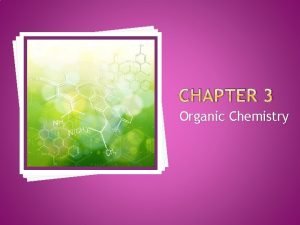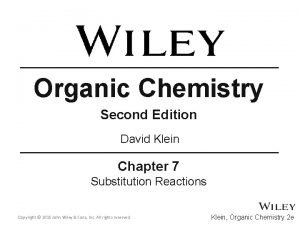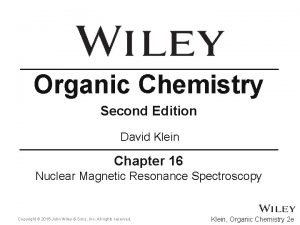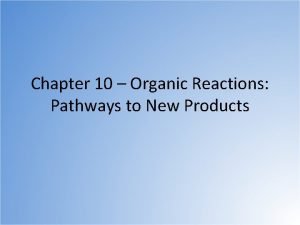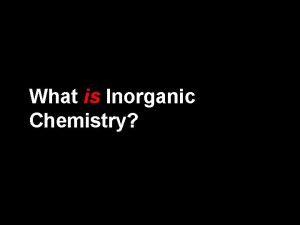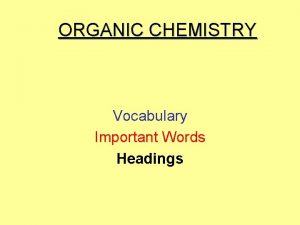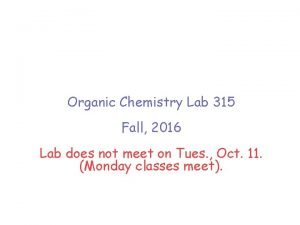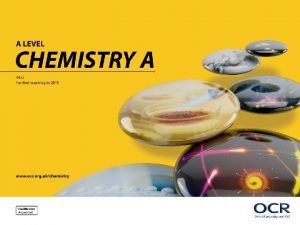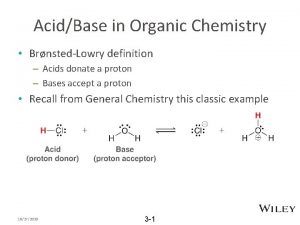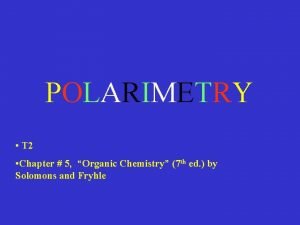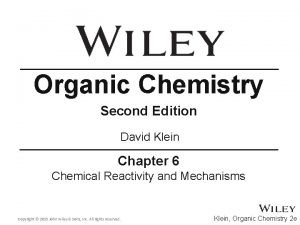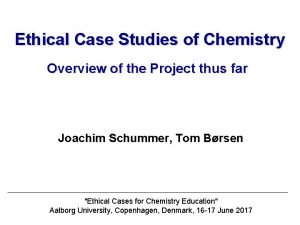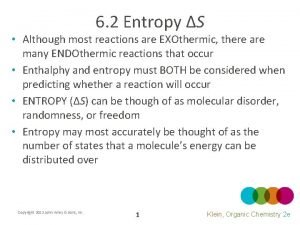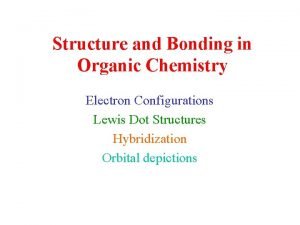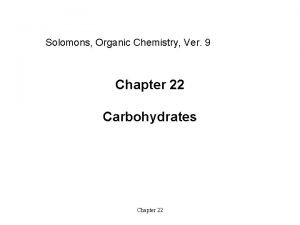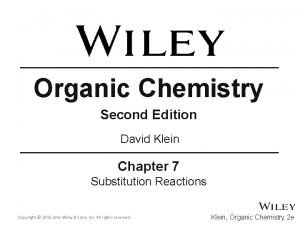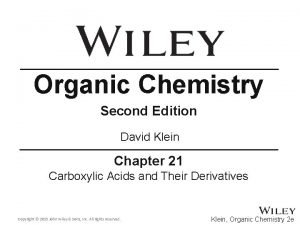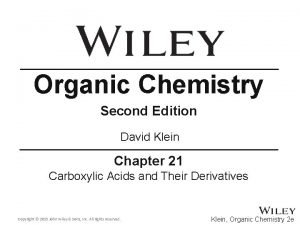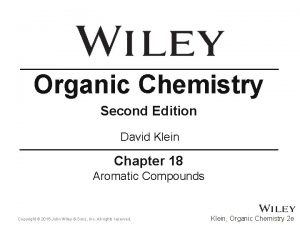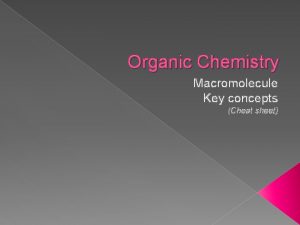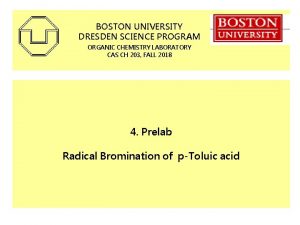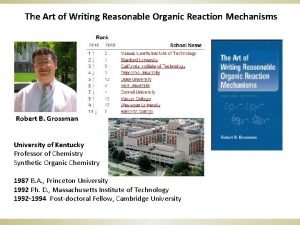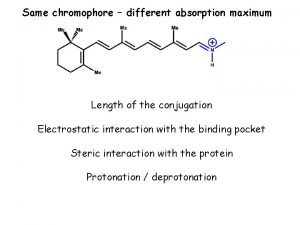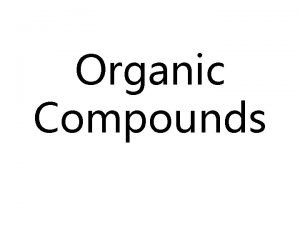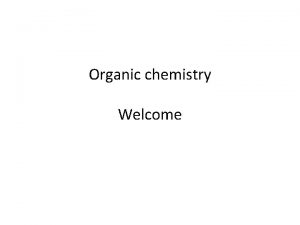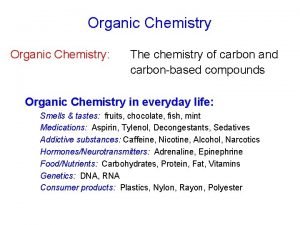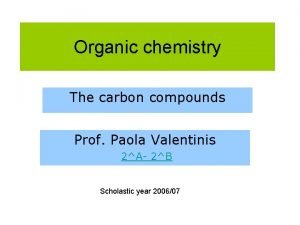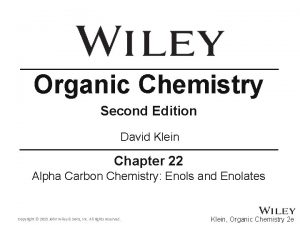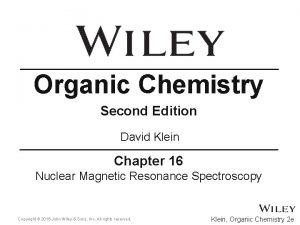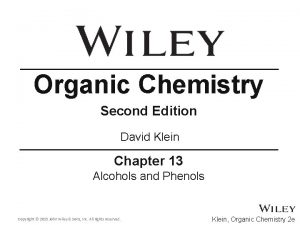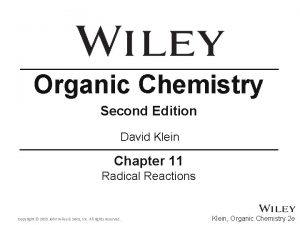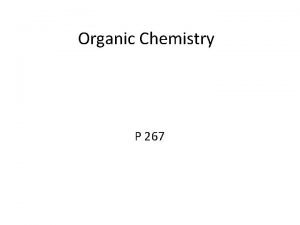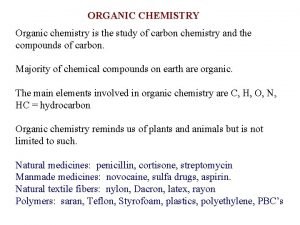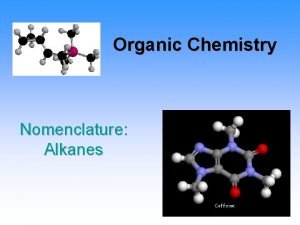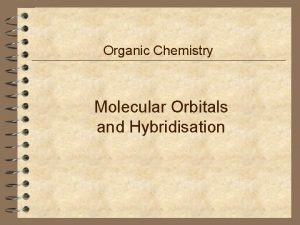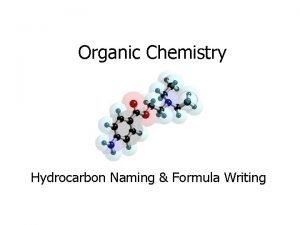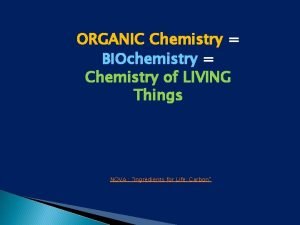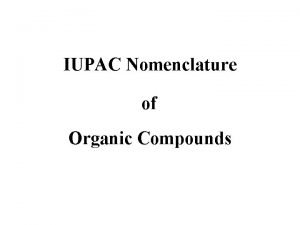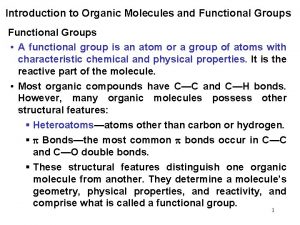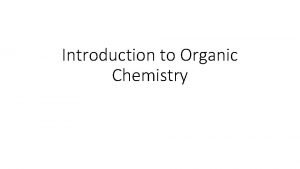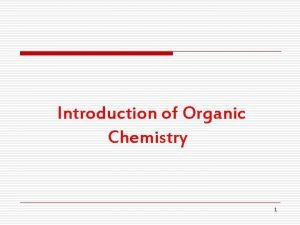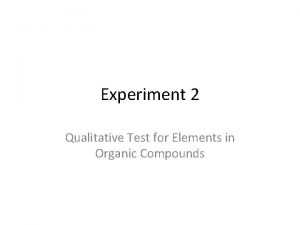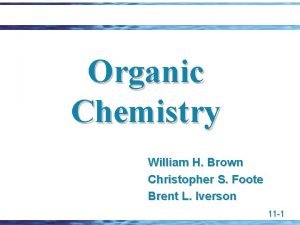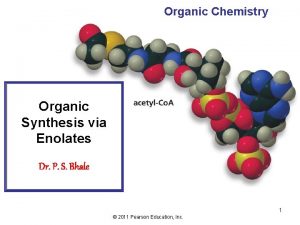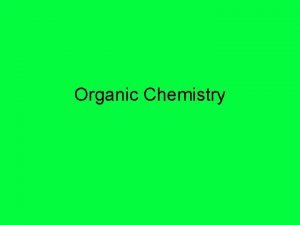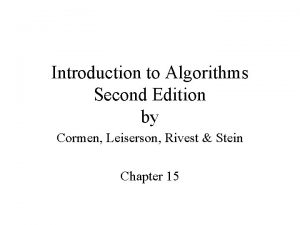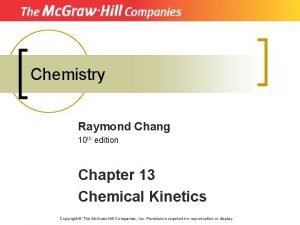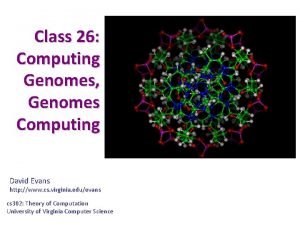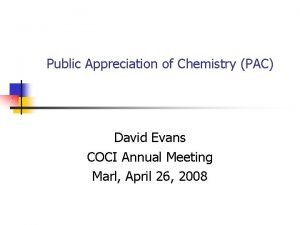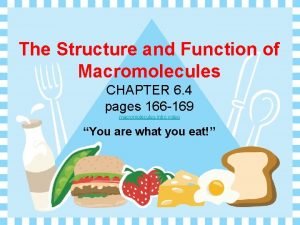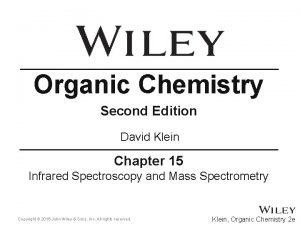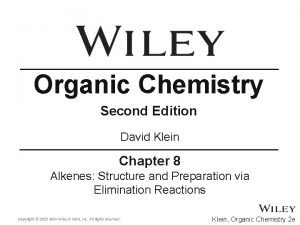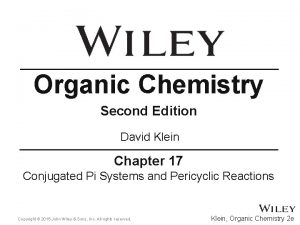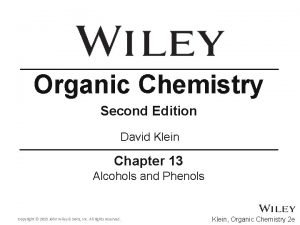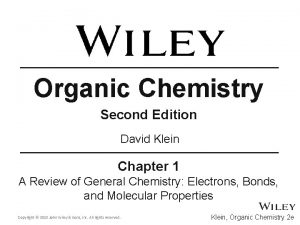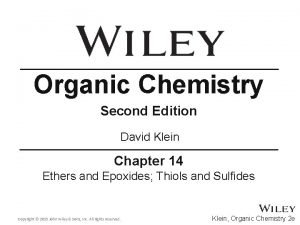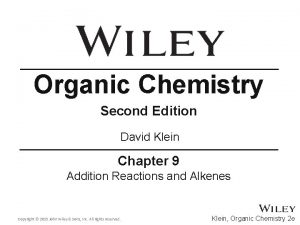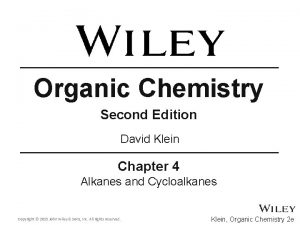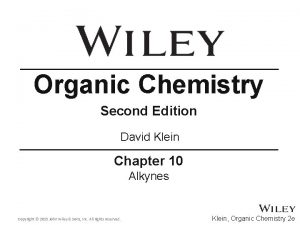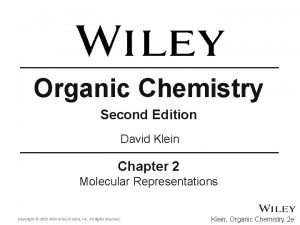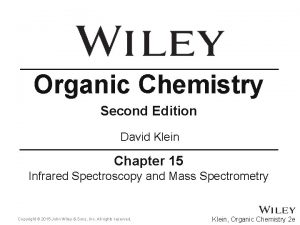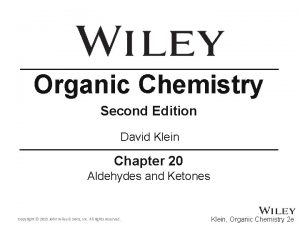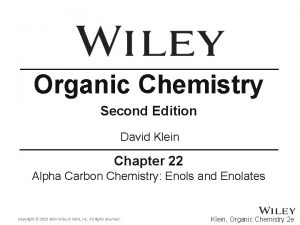Organic Chemistry Second Edition David Klein Chapter 19






























































































































- Slides: 126

Organic Chemistry Second Edition David Klein Chapter 19 Aromatic Substitution Reactions Copyright © 2015 John Wiley & Sons, Inc. All rights reserved. Klein, Organic Chemistry 2 e

19. 1 Introduction to Electrophilic Aromatic Substitution • In chapter 18, we saw how aromatic C=C double bonds are less reactive than typical alkene double bonds • Consider a bromination reaction Copyright © 2015 John Wiley & Sons, Inc. All rights reserved. 19 -2 Klein, Organic Chemistry 2 e

19. 1 Introduction to Electrophilic Aromatic Substitution • When Fe is introduced a reaction occurs • Is the reaction substitution, elimination, addition or pericyclic? Copyright © 2015 John Wiley & Sons, Inc. All rights reserved. 19 -3 Klein, Organic Chemistry 2 e

19. 1 Introduction to Electrophilic Aromatic Substitution • Similar reactions occur for aromatic rings using other reagents • Such reactions are called Electrophilic Aromatic Substitution (EAS) • Explain each term in the EAS title Copyright © 2015 John Wiley & Sons, Inc. All rights reserved. 19 -4 Klein, Organic Chemistry 2 e

19. 2 Halogenation • Do you think an aromatic ring is more likely to act as a nucleophile or an electrophile? WHY? • Do you think Br 2 is more likely to act as a nucleophile or an electrophile? WHY? Copyright © 2015 John Wiley & Sons, Inc. All rights reserved. 19 -5 Klein, Organic Chemistry 2 e

19. 2 Halogenation • To promote the EAS reaction between benzene and Br 2, we saw that Fe is necessary • • Does this process make Bromine a better or worse electrophile? HOW? Copyright © 2015 John Wiley & Sons, Inc. All rights reserved. 19 -6 Klein, Organic Chemistry 2 e

19. 2 Halogenation • The Fe. Br 3 acts as a Lewis acid. HOW? • Al. Br 3 is sometimes used instead of Fe. Br 3 • A resonancestabilized carbocation is formed Copyright © 2015 John Wiley & Sons, Inc. All rights reserved. 19 -7 Klein, Organic Chemistry 2 e

19. 2 Halogenation • The resonance stabilized carbocation is called a Sigma Complex or arenium ion • Draw the resonance hybrid Copyright © 2015 John Wiley & Sons, Inc. All rights reserved. 19 -8 Klein, Organic Chemistry 2 e

19. 2 Halogenation • The Sigma Complex is re-aromatized • Does the Fe. Br 3 act as catalyst? Copyright © 2015 John Wiley & Sons, Inc. All rights reserved. 19 -9 Klein, Organic Chemistry 2 e

19. 2 Halogenation • Substitution occurs rather than addition. WHY? Copyright © 2015 John Wiley & Sons, Inc. All rights reserved. 19 -10 Klein, Organic Chemistry 2 e

19. 2 Halogenation • Cl 2 can be used instead of Br 2 • Draw the EAS mechanism for the reaction between benzene and Cl 2 with Al. Cl 3 as a Lewis acid catalyst • Fluorination is generally too violent to be practical, and iodination is generally slow with low yields Copyright © 2015 John Wiley & Sons, Inc. All rights reserved. 19 -11 Klein, Organic Chemistry 2 e

19. 2 Halogenation • Note the general EAS mechanism • Practice with conceptual checkpoint 19. 1 Copyright © 2015 John Wiley & Sons, Inc. All rights reserved. 19 -12 Klein, Organic Chemistry 2 e

Copyright © 2015 John Wiley & Sons, Inc. All rights reserved. Klein, Organic Chemistry 2 e

19. 3 Sulfonation • There are many different electrophiles that can be attacked by an aromatic ring • Fuming H 2 SO 4 consists of sulfuric acid and SO 3 gas • SO 3 is quite electrophilic. HOW? Copyright © 2015 John Wiley & Sons, Inc. All rights reserved. 19 -14 Klein, Organic Chemistry 2 e

19. 3 Sulfonation • Let’s examine SO 3 in more detail • The S=O double bond involves p-orbital overlap that is less effective than the orbital overlap in a C=C double bond. WHY? • As a result, the S=O double bond behaves more as a S-O single bond with formal charges. WHAT are the charges? Copyright © 2015 John Wiley & Sons, Inc. All rights reserved. 19 -15 Klein, Organic Chemistry 2 e

19. 3 Sulfonation • The S atom in SO 3 carries a great deal of positive charge • The aromatic ring is stable, but it is also electron-rich • When the ring attacks SO 3, the resulting carbocation is resonance stabilized • Draw the resonance contributors and the resonance hybrid Copyright © 2015 John Wiley & Sons, Inc. All rights reserved. 19 -16 Klein, Organic Chemistry 2 e

19. 3 Sulfonation • As in every EAS mechanism, a proton transfer re-aromatizes the ring Copyright © 2015 John Wiley & Sons, Inc. All rights reserved. 19 -17 Klein, Organic Chemistry 2 e

19. 3 Sulfonation • The spontaneity of the sulfonation reaction depends on the concentration • We will examine the equilibrium process in more detail later in this chapter • Practice with conceptual checkpoints 19. 2 and 19. 3 Copyright © 2015 John Wiley & Sons, Inc. All rights reserved. 19 -18 Klein, Organic Chemistry 2 e

Copyright © 2015 John Wiley & Sons, Inc. All rights reserved. Klein, Organic Chemistry 2 e

Copyright © 2015 John Wiley & Sons, Inc. All rights reserved. Klein, Organic Chemistry 2 e

19. 4 Nitration • A mixture of sulfuric acid and nitric acid causes the ring to undergo nitration • The nitronium ion is highly electrophilic Copyright © 2015 John Wiley & Sons, Inc. All rights reserved. 19 -21 Klein, Organic Chemistry 2 e

19. 4 Nitration • The ring attacks the nitronium ion Copyright © 2015 John Wiley & Sons, Inc. All rights reserved. 19 -22 Klein, Organic Chemistry 2 e

19. 4 Nitration • The sigma complex stabilizes the carbocation Copyright © 2015 John Wiley & Sons, Inc. All rights reserved. 19 -23 Klein, Organic Chemistry 2 e

19. 4 Nitration • As with any EAS mechanism, the ring is re-aromatized Copyright © 2015 John Wiley & Sons, Inc. All rights reserved. 19 -24 Klein, Organic Chemistry 2 e

19. 4 Nitration • A nitro group can be reduced to form an amine • Combining the reactions gives us a 2 -step process for installing an amino group • Practice with conceptual checkpoint 19. 4 Copyright © 2015 John Wiley & Sons, Inc. All rights reserved. 19 -25 Klein, Organic Chemistry 2 e

Copyright © 2015 John Wiley & Sons, Inc. All rights reserved. Klein, Organic Chemistry 2 e

19. 5 Friedel-Crafts Alkylation • Do you think that an alkyl halide is an effective nucleophile for EAS? Copyright © 2015 John Wiley & Sons, Inc. All rights reserved. 19 -27 Klein, Organic Chemistry 2 e

19. 5 Friedel-Crafts Alkylation • In the presence of a Lewis acid catalyst, alkylation is generally favored • What role do you think the Lewis acid plays? Copyright © 2015 John Wiley & Sons, Inc. All rights reserved. 19 -28 Klein, Organic Chemistry 2 e

19. 5 Friedel-Crafts Alkylation • A carbocation is generated • The ring then attacks the carbocation • Show a full mechanism Copyright © 2015 John Wiley & Sons, Inc. All rights reserved. 19 -29 Klein, Organic Chemistry 2 e

19. 5 Friedel-Crafts Alkylation • Primary carbocations are too unstable to form, yet primary alkyl halides can react under Friedel-Crafts conditions • First the alkyl halide reacts with the Lewis acid – show the product Copyright © 2015 John Wiley & Sons, Inc. All rights reserved. 19 -30 Klein, Organic Chemistry 2 e

19. 5 Friedel-Crafts Alkylation • The alkyl halide / Lewis acid complex can undergo a hydride shift • Show the mechanism continues to provide the major product of the reaction Copyright © 2015 John Wiley & Sons, Inc. All rights reserved. 19 -31 Klein, Organic Chemistry 2 e

19. 5 Friedel-Crafts Alkylation • The alkyl halide / Lewis acid complex can also be attacked directly by the aromatic ring • Show the mechanism provides the minor product • Why might the hydride shift occur more readily than the direct attack? • Why are reactions that give mixtures of products often impractical? Copyright © 2015 John Wiley & Sons, Inc. All rights reserved. 19 -32 Klein, Organic Chemistry 2 e

19. 5 Friedel-Crafts Alkylation • There are three major limitations to Friedel-Crafts alkylations 1. The halide leaving group must be attached to an sp 3 hybridized carbon Copyright © 2015 John Wiley & Sons, Inc. All rights reserved. 19 -33 Klein, Organic Chemistry 2 e

19. 5 Friedel-Crafts Alkylation • There are three major limitations to Friedel-Crafts alkylations 2. Polyalkylation can occur We will see later in this chapter how to control polyalkylation Copyright © 2015 John Wiley & Sons, Inc. All rights reserved. 19 -34 Klein, Organic Chemistry 2 e

19. 5 Friedel-Crafts Alkylation • There are three major limitations to Friedel-Crafts alkylations 3. Some substituted aromatic rings such as nitrobenzene are too deactivated to react We will explore deactivating groups later in this chapter • Practice with conceptual checkpoints 19. 5, 19. 6, and 19. 7 Copyright © 2015 John Wiley & Sons, Inc. All rights reserved. 19 -35 Klein, Organic Chemistry 2 e

Copyright © 2015 John Wiley & Sons, Inc. All rights reserved. Klein, Organic Chemistry 2 e

Copyright © 2015 John Wiley & Sons, Inc. All rights reserved. Klein, Organic Chemistry 2 e

Copyright © 2015 John Wiley & Sons, Inc. All rights reserved. Klein, Organic Chemistry 2 e

Copyright © 2015 John Wiley & Sons, Inc. All rights reserved. Klein, Organic Chemistry 2 e

19. 6 Friedel-Crafts Acylation • Acylation and alkylation both form a new carbon-carbon bond • Acylation reactions are also generally catalyzed with a Lewis acid Copyright © 2015 John Wiley & Sons, Inc. All rights reserved. 19 -40 Klein, Organic Chemistry 2 e

19. 6 Friedel-Crafts Acylation • Acylation proceeds through an acylium ion Copyright © 2015 John Wiley & Sons, Inc. All rights reserved. 19 -41 Klein, Organic Chemistry 2 e

19. 6 Friedel-Crafts Acylation • The acylium ion is stabilized by resonance • The acylium ion generally does not rearrange because of the resonance • Draw a complete mechanism for the reaction between benzene and the acylium ion Copyright © 2015 John Wiley & Sons, Inc. All rights reserved. 19 -42 Klein, Organic Chemistry 2 e

19. 6 Friedel-Crafts Acylation • Some alkyl groups cannot be attached to a ring by Friedel-Crafts alkylation because of rearrangements • An acylation followed by a Clemmensen reduction is a good alternative Copyright © 2015 John Wiley & Sons, Inc. All rights reserved. 19 -43 Klein, Organic Chemistry 2 e

19. 6 Friedel-Crafts Acylation • Unlike polyalkylation, polyacylation is generally not observed. We will discuss WHY later in this chapter • Practice with conceptual checkpoint 19. 8 through 19. 10 Copyright © 2015 John Wiley & Sons, Inc. All rights reserved. 19 -44 Klein, Organic Chemistry 2 e

Copyright © 2015 John Wiley & Sons, Inc. All rights reserved. Klein, Organic Chemistry 2 e

Copyright © 2015 John Wiley & Sons, Inc. All rights reserved. Klein, Organic Chemistry 2 e

Copyright © 2015 John Wiley & Sons, Inc. All rights reserved. Klein, Organic Chemistry 2 e

19. 7 Activating Groups • Substituted benzenes may undergo EAS reactions with faster RATES than unsubstituted benzene. What is rate? • Toluene undergoes nitration 25 times faster than benzene • The methyl group activates the ring through induction (hyperconjugation). Explain HOW Copyright © 2015 John Wiley & Sons, Inc. All rights reserved. 19 -48 Klein, Organic Chemistry 2 e

19. 7 Activating Groups • Substituted benzenes generally undergo EAS reactions regioselectively Copyright © 2015 John Wiley & Sons, Inc. All rights reserved. 19 -49 Klein, Organic Chemistry 2 e

19. 7 Activating Groups • The relative position of the methyl group and the approaching electrophile affects the stability of the sigma complex • If the ring attacks from the ortho position, the first resonance contributor of the sigma complex is stabilized. HOW? • Is the transition state also affected? Copyright © 2015 John Wiley & Sons, Inc. All rights reserved. 19 -50 Klein, Organic Chemistry 2 e

19. 7 Activating Groups • The relative position of the methyl group and the approaching electrophile affects the stability of the sigma complex Copyright © 2015 John Wiley & Sons, Inc. All rights reserved. 19 -51 Klein, Organic Chemistry 2 e

19. 7 Activating Groups • Explain the trend below • The ortho product predominates for statistical reasons despite some slight steric crowding • Practice with conceptual checkpoint 19. 11 Copyright © 2015 John Wiley & Sons, Inc. All rights reserved. 19 -52 Klein, Organic Chemistry 2 e

Copyright © 2015 John Wiley & Sons, Inc. All rights reserved. Klein, Organic Chemistry 2 e

19. 7 Activating Groups • The methoxy group in anisole activates the ring 400 times more than benzene • Through induction, is a methoxy group electron withdrawing or donating? HOW? • The methoxy group donates through resonance • Which resonance structure contributes most to the resonance hybrid? Copyright © 2015 John Wiley & Sons, Inc. All rights reserved. 19 -54 Klein, Organic Chemistry 2 e

19. 7 Activating Groups • The methoxy group activates the ring so strongly that polysubstitution is difficult to avoid • Activators are generally ortho-para directors Copyright © 2015 John Wiley & Sons, Inc. All rights reserved. 19 -55 Klein, Organic Chemistry 2 e

19. 7 Activating Groups • The resonance stabilization affects the regioselectivity Copyright © 2015 John Wiley & Sons, Inc. All rights reserved. 19 -56 Klein, Organic Chemistry 2 e

19. 7 Activating Groups • How will the methoxy group affect the transition state? • The para product is the major product. WHY? Copyright © 2015 John Wiley & Sons, Inc. All rights reserved. 19 -57 Klein, Organic Chemistry 2 e

19. 7 Activating Groups • All activators are ortho -para directors • Give reactants necessary for the conversion below • Practice with conceptual checkpoint 19. 12 Copyright © 2015 John Wiley & Sons, Inc. All rights reserved. 19 -58 Klein, Organic Chemistry 2 e

Copyright © 2015 John Wiley & Sons, Inc. All rights reserved. Klein, Organic Chemistry 2 e

19. 8 Deactivating Groups • The nitro group is electron withdrawing through both resonance and induction. Explain HOW • Withdrawing electrons from the ring deactivates it. HOW? • Will withdrawing electrons make the transition state or the intermediate less stable? Copyright © 2015 John Wiley & Sons, Inc. All rights reserved. 19 -60 Klein, Organic Chemistry 2 e

19. 8 Deactivating Groups Copyright © 2015 John Wiley & Sons, Inc. All rights reserved. 19 -61 Klein, Organic Chemistry 2 e

19. 8 Deactivating Groups • The meta product predominates because the other positions are deactivated • Practice with conceptual checkpoint 19. 13 Copyright © 2015 John Wiley & Sons, Inc. All rights reserved. 19 -62 Klein, Organic Chemistry 2 e

Copyright © 2015 John Wiley & Sons, Inc. All rights reserved. Klein, Organic Chemistry 2 e

19. 9 Halogens: The Exception • All electron donating groups are ortho-para directors • All electron withdrawing groups are meta-directors EXCEPT the halogens • Halogens withdraw electrons by induction (deactivating) • Halogens donate electrons through resonance (orthopara directing) Copyright © 2015 John Wiley & Sons, Inc. All rights reserved. 19 -64 Klein, Organic Chemistry 2 e

19. 9 Halogens: The Exception • Halogens donate electrons through resonance Copyright © 2015 John Wiley & Sons, Inc. All rights reserved. 19 -65 Klein, Organic Chemistry 2 e

Copyright © 2015 John Wiley & Sons, Inc. All rights reserved. Klein, Organic Chemistry 2 e

19. 10 Determining the Directing Effects of a Substituent • Let’s summarize the directing effects of more substituents 1. STRONG activators. WHAT makes them strong? 2. Moderate activators. What makes them moderate? Copyright © 2015 John Wiley & Sons, Inc. All rights reserved. 19 -67 Klein, Organic Chemistry 2 e

19. 10 Determining the Directing Effects of a Substituent • Let’s summarize the directing effects of more substituents 3. WEAK activators. WHAT makes them weak? 4. WEAK deactivators. WHAT makes them weak? Copyright © 2015 John Wiley & Sons, Inc. All rights reserved. 19 -68 Klein, Organic Chemistry 2 e

19. 10 Determining the Directing Effects of a Substituent • Let’s summarize the directing effects of more substituents 5. Moderate deactivators. WHAT makes them moderate? 6. STRONG deactivators. WHAT makes them strong? Copyright © 2015 John Wiley & Sons, Inc. All rights reserved. 19 -69 Klein, Organic Chemistry 2 e

19. 10 Determining the Directing Effects of a Substituent • For the compound below, determine whether the group is electron withdrawing or donating • Also, determine if it is activating or deactivating and how strongly or weakly • Finally, determine whether it is ortho, para, or meta directing • Practice with Skill. Builder 19. 1 Copyright © 2015 John Wiley & Sons, Inc. All rights reserved. 19 -70 Klein, Organic Chemistry 2 e

Copyright © 2015 John Wiley & Sons, Inc. All rights reserved. Klein, Organic Chemistry 2 e

19. 11 Multiple Substituents • The directing effects of all substituents attached to a ring must be considered in an EAS reaction • Predict the major product for the reaction below and EXPLAIN Copyright © 2015 John Wiley & Sons, Inc. All rights reserved. 19 -72 Klein, Organic Chemistry 2 e

19. 11 Multiple Substituents • Predict the major product for the reaction below and EXPLAIN • Practice with Skill. Builder 19. 2 Copyright © 2015 John Wiley & Sons, Inc. All rights reserved. 19 -73 Klein, Organic Chemistry 2 e

Copyright © 2015 John Wiley & Sons, Inc. All rights reserved. Klein, Organic Chemistry 2 e

19. 11 Multiple Substituents • Consider sterics in addition to resonance and induction to predict which product below is major and which is minor Copyright © 2015 John Wiley & Sons, Inc. All rights reserved. 19 -75 Klein, Organic Chemistry 2 e

19. 11 Multiple Substituents • Consider sterics in addition to resonance and induction to predict which product below is major and which is minor • Substitution is very unlikely to occur in between two substituents. WHY? • Practice with Skill. Builder 19. 3 Copyright © 2015 John Wiley & Sons, Inc. All rights reserved. 19 -76 Klein, Organic Chemistry 2 e

Copyright © 2015 John Wiley & Sons, Inc. All rights reserved. Klein, Organic Chemistry 2 e

19. 11 Multiple Substituents • What reagents might you use for the following reaction? • Is there a way to promote the desired ortho substitution over substitution at the less hindered para position? • Maybe you could first block out the para position Copyright © 2015 John Wiley & Sons, Inc. All rights reserved. 19 -78 Klein, Organic Chemistry 2 e

19. 11 Multiple Substituents • Because EAS sulfonation is reversible, it can be used as a temporary blocking group • Practice with Skill. Builder 19. 4 Copyright © 2015 John Wiley & Sons, Inc. All rights reserved. 19 -79 Klein, Organic Chemistry 2 e

Copyright © 2015 John Wiley & Sons, Inc. All rights reserved. Klein, Organic Chemistry 2 e

Copyright © 2015 John Wiley & Sons, Inc. All rights reserved. Klein, Organic Chemistry 2 e

19. 12 Synthetic Strategies • Reagents for monosubstituted aromatic compounds • Practice with conceptual checkpoints 19. 28 and 19. 29 Copyright © 2015 John Wiley & Sons, Inc. All rights reserved. 19 -82 Klein, Organic Chemistry 2 e

Copyright © 2015 John Wiley & Sons, Inc. All rights reserved. Klein, Organic Chemistry 2 e

Copyright © 2015 John Wiley & Sons, Inc. All rights reserved. Klein, Organic Chemistry 2 e

Copyright © 2015 John Wiley & Sons, Inc. All rights reserved. Klein, Organic Chemistry 2 e

Copyright © 2015 John Wiley & Sons, Inc. All rights reserved. Klein, Organic Chemistry 2 e

Copyright © 2015 John Wiley & Sons, Inc. All rights reserved. Klein, Organic Chemistry 2 e

19. 12 Synthetic Strategies • To synthesize di-substituted aromatic compounds, you must carefully analysis the directing groups • How might you make 3 -nitrobromobenzene? • How might you make 3 -chloroaniline? • Such a reaction is much more challenging, because –NH 2 and–Cl groups are both para directing • A meta director will be used to install the two groups • One of the groups will subsequently be converted into its final form – use examples on the next slide Copyright © 2015 John Wiley & Sons, Inc. All rights reserved. 19 -88 Klein, Organic Chemistry 2 e

How might you make 3 -nitrobromobenzene? How might you make 3 -chloroaniline? Copyright © 2015 John Wiley & Sons, Inc. All rights reserved. Klein, Organic Chemistry 2 e

19. 12 Synthetic Strategies Copyright © 2015 John Wiley & Sons, Inc. All rights reserved. 19 -90 Klein, Organic Chemistry 2 e

19. 12 Synthetic Strategies • There are limitations you should be aware of for some EAS reactions 1. Nitration conditions generally cause amine oxidation leading to a mixture of undesired products Copyright © 2015 John Wiley & Sons, Inc. All rights reserved. 19 -91 Klein, Organic Chemistry 2 e

19. 12 Synthetic Strategies 2. Friedel-Crafts reactions are too slow to be practical when a deactivating group is present on a ring • Practice with Skill. Builder 19. 5 Copyright © 2015 John Wiley & Sons, Inc. All rights reserved. 19 -92 Klein, Organic Chemistry 2 e

Copyright © 2015 John Wiley & Sons, Inc. All rights reserved. Klein, Organic Chemistry 2 e

Copyright © 2015 John Wiley & Sons, Inc. All rights reserved. Klein, Organic Chemistry 2 e

19. 12 Synthetic Strategies • When designing a synthesis for a polysubstituted aromatic compound, often a retrosynthetic analysis is helpful • Design a synthesis for the molecule below • Which group would be the LAST group attached? • WHY can’t the bromo or acyl groups be attached last? Copyright © 2015 John Wiley & Sons, Inc. All rights reserved. 19 -95 Klein, Organic Chemistry 2 e

Copyright © 2015 John Wiley & Sons, Inc. All rights reserved. Klein, Organic Chemistry 2 e

Copyright © 2015 John Wiley & Sons, Inc. All rights reserved. Klein, Organic Chemistry 2 e

19. 12 Synthetic Strategies • Once the ring only has two substituents, it should be easier to work forward • Explain why other possible synthetic routes are not likely to yield as much of the final product • Continue Skill. Builder 19. 6 Copyright © 2015 John Wiley & Sons, Inc. All rights reserved. 19 -98 Klein, Organic Chemistry 2 e

Copyright © 2015 John Wiley & Sons, Inc. All rights reserved. Klein, Organic Chemistry 2 e

Copyright © 2015 John Wiley & Sons, Inc. All rights reserved. Klein, Organic Chemistry 2 e

Copyright © 2015 John Wiley & Sons, Inc. All rights reserved. Klein, Organic Chemistry 2 e

Copyright © 2015 John Wiley & Sons, Inc. All rights reserved. Klein, Organic Chemistry 2 e

Copyright © 2015 John Wiley & Sons, Inc. All rights reserved. Klein, Organic Chemistry 2 e

19. 13 Nucleophilic Aromatic Substitution • Consider the reaction below in which the aromatic ring is attacked by a nucleophile • Is there a leaving group? Copyright © 2015 John Wiley & Sons, Inc. All rights reserved. 19 -104 Klein, Organic Chemistry 2 e

19. 13 Nucleophilic Aromatic Substitution • Aromatic rings are generally electron-rich, which allows them to attack electrophiles (EAS) • To facilitate attack by a nucleophile: 1. A ring must be electron poor. WHY? A ring must be substituted with a strong electron withdrawing group 2. There must be a good leaving group 3. The leaving group must be positioned ORTHO or PARA to the withdrawing group. WHY? We must investigate the mechanism – see next slide Copyright © 2015 John Wiley & Sons, Inc. All rights reserved. 19 -105 Klein, Organic Chemistry 2 e

19. 13 Nucleophilic Aromatic Substitution • Draw all of the resonance contributors in the intermediate Copyright © 2015 John Wiley & Sons, Inc. All rights reserved. 19 -106 Klein, Organic Chemistry 2 e

19. 13 Nucleophilic Aromatic Substitution • In the last step of the mechanism, the leaving group is pushed out as the ring re-aromatizes Copyright © 2015 John Wiley & Sons, Inc. All rights reserved. 19 -107 Klein, Organic Chemistry 2 e

19. 13 Nucleophilic Aromatic Substitution • How would the stability of the transition state and intermediate differ for the following molecule? Copyright © 2015 John Wiley & Sons, Inc. All rights reserved. 19 -108 Klein, Organic Chemistry 2 e

19. 13 Nucleophilic Aromatic Substitution • The excess hydroxide that is used to drive the reaction forward will deprotonate the phenol, so acid must be used after the NAS steps are complete • Practice with conceptual checkpoints 19. 35 through 19. 37 Copyright © 2015 John Wiley & Sons, Inc. All rights reserved. 19 -109 Klein, Organic Chemistry 2 e

Copyright © 2015 John Wiley & Sons, Inc. All rights reserved. Klein, Organic Chemistry 2 e

19. 14 Elimination Addition • Without the presence of a strong electron withdrawing group, mild NAS conditions will not produce a product • Significantly harsher conditions are required Copyright © 2015 John Wiley & Sons, Inc. All rights reserved. 19 -111 Klein, Organic Chemistry 2 e

19. 14 Elimination Addition • The reaction works even better when a stronger nucleophile is used • Why is NH 2 - a stronger nucleophile than OH-? Copyright © 2015 John Wiley & Sons, Inc. All rights reserved. 19 -112 Klein, Organic Chemistry 2 e

19. 14 Elimination Addition • Consider the substitution reaction using toluene • The product regioselectivity cannot be explained using the NAS mechanism we discussed previously • Isotopic labeling can help to elucidate the mechanism – see next slide Copyright © 2015 John Wiley & Sons, Inc. All rights reserved. 19 -113 Klein, Organic Chemistry 2 e

19. 14 Elimination Addition • The C* is a 14 C label • The NH 2 - first acts as a base rather than as a nucleophile Copyright © 2015 John Wiley & Sons, Inc. All rights reserved. 19 -114 Klein, Organic Chemistry 2 e

19. 14 Elimination Addition • The benzyne intermediate is a shortlived unstable intermediate • Does a 6 -membered ring allow for sp hybridized carbons? • The benzyne triple bond resembles more closely an sp 2 -sp 2 overlap than it resembles a p-p overlap Copyright © 2015 John Wiley & Sons, Inc. All rights reserved. 19 -115 Klein, Organic Chemistry 2 e

19. 14 Elimination Addition • A second molecule of NH 2 - acts as a nucleophile by attacking either side of the triple bond • Does NH 2 - act as a catalyst? Copyright © 2015 John Wiley & Sons, Inc. All rights reserved. 19 -116 Klein, Organic Chemistry 2 e

19. 14 Elimination Addition • Further evidence for the existence of the benzyne intermediate can be seen when the benzyne is allowed to react with a diene via a Diels Alder reaction • Practice with conceptual checkpoint 19. 38 and 19. 39 Copyright © 2015 John Wiley & Sons, Inc. All rights reserved. 19 -117 Klein, Organic Chemistry 2 e

Copyright © 2015 John Wiley & Sons, Inc. All rights reserved. Klein, Organic Chemistry 2 e

19. 15 Identifying the Mechanism of an Aromatic Substitution Reaction • The flow chart below can be used to identify the proper substitution mechanism • Practice with Skill. Builder 19. 7 Copyright © 2015 John Wiley & Sons, Inc. All rights reserved. 19 -119 Klein, Organic Chemistry 2 e

Copyright © 2015 John Wiley & Sons, Inc. All rights reserved. Klein, Organic Chemistry 2 e

Copyright © 2015 John Wiley & Sons, Inc. All rights reserved. Klein, Organic Chemistry 2 e

Copyright © 2015 John Wiley & Sons, Inc. All rights reserved. Klein, Organic Chemistry 2 e

Additional Practice Problems • Give the products for the reaction below and a complete mechanism Copyright © 2015 John Wiley & Sons, Inc. All rights reserved. 19 -123 Klein, Organic Chemistry 2 e

Additional Practice Problems • Predict the major product for each reaction below Copyright © 2015 John Wiley & Sons, Inc. All rights reserved. 19 -124 Klein, Organic Chemistry 2 e

Additional Practice Problems • Give necessary reagents for the synthesis below Copyright © 2015 John Wiley & Sons, Inc. All rights reserved. 19 -125 Klein, Organic Chemistry 2 e

Additional Practice Problems • Fill in the blanks below Copyright © 2015 John Wiley & Sons, Inc. All rights reserved. 19 -126 Klein, Organic Chemistry 2 e
 Organic chemistry second edition david klein
Organic chemistry second edition david klein Rearranged most stable carbocation is
Rearranged most stable carbocation is David klein organic chemistry
David klein organic chemistry Organic chemistry david klein 3rd edition
Organic chemistry david klein 3rd edition Organic chemistry third edition david klein
Organic chemistry third edition david klein Organic chemistry 2nd edition klein
Organic chemistry 2nd edition klein Klein organic chemistry 2nd edition
Klein organic chemistry 2nd edition Thermodynamic vs kinetic control
Thermodynamic vs kinetic control Halohydrin formation
Halohydrin formation Ib organic chemistry
Ib organic chemistry Organic vs inorganic chemistry
Organic vs inorganic chemistry Importance of organic chemistry
Importance of organic chemistry Chapter 22 review organic chemistry section 1 answers
Chapter 22 review organic chemistry section 1 answers Organic chemistry chapter 9
Organic chemistry chapter 9 What functional group is ch3
What functional group is ch3 This name
This name Organic chemistry chapter 1 problem 59pp
Organic chemistry chapter 1 problem 59pp David klein
David klein Organic chemistry
Organic chemistry Founder of organic chemistry
Founder of organic chemistry Chemistry of soap making
Chemistry of soap making Ester organic chemistry
Ester organic chemistry Examples of isomers in chemistry
Examples of isomers in chemistry Ee organic chemistry
Ee organic chemistry Ario organic chemistry
Ario organic chemistry Leveling effect organic chemistry
Leveling effect organic chemistry Cn functional group
Cn functional group Organic chemistry lab report sample
Organic chemistry lab report sample Organic chemistry conversion chart
Organic chemistry conversion chart Grade 10 organic chemistry
Grade 10 organic chemistry Organic chemistry
Organic chemistry Organic chemistry wade
Organic chemistry wade Chemistry meth eth prop but
Chemistry meth eth prop but Alkane cracking
Alkane cracking Meth eth prop but
Meth eth prop but Organic chemistry myanmar
Organic chemistry myanmar Electrophilic addition hbr
Electrophilic addition hbr Alpha cleavage
Alpha cleavage Hono organic chemistry
Hono organic chemistry Propyl bromide
Propyl bromide Organic chemistry topic 11
Organic chemistry topic 11 Organic chemistry reaction pathways
Organic chemistry reaction pathways Alkene alcohol naming
Alkene alcohol naming What is organic chemistry like
What is organic chemistry like Neon organic or inorganic
Neon organic or inorganic Organic chemistry vocabulary
Organic chemistry vocabulary Extraction of caffeine from vivarin tablets lab report
Extraction of caffeine from vivarin tablets lab report A level chemistry ocr organic synthesis
A level chemistry ocr organic synthesis Biological importance of fats
Biological importance of fats Leveling effect organic chemistry
Leveling effect organic chemistry Percentage yield practice questions
Percentage yield practice questions Polarimetry organic chemistry
Polarimetry organic chemistry Radicals
Radicals Hammonds postulate
Hammonds postulate Organic chemistry case studies
Organic chemistry case studies Hammond's postulate organic chemistry
Hammond's postulate organic chemistry Structure and bonding in organic chemistry
Structure and bonding in organic chemistry Oxidation of carbohydrates
Oxidation of carbohydrates Organic chemistry
Organic chemistry Organic chemistry
Organic chemistry Organic chemistry
Organic chemistry Organic chemistry
Organic chemistry Organic chemistry cheat sheet
Organic chemistry cheat sheet Mind map organic chemistry
Mind map organic chemistry Ethos
Ethos Bu organic chemistry
Bu organic chemistry The art of writing reasonable organic reaction mechanisms
The art of writing reasonable organic reaction mechanisms Rhodopsin cgmp
Rhodopsin cgmp Organic chemistry
Organic chemistry Cyclopentane condensed structural formula
Cyclopentane condensed structural formula Organic chemistry
Organic chemistry 4 isomers of hexane
4 isomers of hexane Organic chemistry
Organic chemistry Organic chemistry
Organic chemistry Organic chemistry
Organic chemistry Chemistry
Chemistry Nbs reaction
Nbs reaction Organic chemistry
Organic chemistry Butan 2 on
Butan 2 on Organic chemistry
Organic chemistry Organic chemistry class 11 notes
Organic chemistry class 11 notes Hybridisation
Hybridisation Condensed formula
Condensed formula Organic chemistry nova
Organic chemistry nova Resonance hybrid
Resonance hybrid C-c-c-c-c chemistry
C-c-c-c-c chemistry Functional group
Functional group Organic chemistry
Organic chemistry Pent oct hept hex
Pent oct hept hex Lassaigne test
Lassaigne test Cis-2 3-dimethyloxirane
Cis-2 3-dimethyloxirane Enols and enolates organic chemistry
Enols and enolates organic chemistry Organic chemistry
Organic chemistry Brooklyn college organic chemistry
Brooklyn college organic chemistry 27 miles per gallon into kilometers per liter
27 miles per gallon into kilometers per liter Advanced word power second edition answers
Advanced word power second edition answers Accounting principles second canadian edition
Accounting principles second canadian edition Accounting principles second canadian edition
Accounting principles second canadian edition Accounting principles second canadian edition
Accounting principles second canadian edition Clear thinking and writing second edition answer key
Clear thinking and writing second edition answer key Accounting principles second canadian edition
Accounting principles second canadian edition Kaufman test of educational achievement second edition
Kaufman test of educational achievement second edition Introduction to algorithms 2nd edition
Introduction to algorithms 2nd edition In company second edition
In company second edition Wechsler individual achievement test second edition
Wechsler individual achievement test second edition Ten steps to advanced reading answer key
Ten steps to advanced reading answer key Mis chapter 6
Mis chapter 6 Zulily case study
Zulily case study Introductory chemistry 4th edition
Introductory chemistry 4th edition Introductory chemistry 5th edition nivaldo j. tro
Introductory chemistry 5th edition nivaldo j. tro Introductory chemistry 5th edition nivaldo j. tro
Introductory chemistry 5th edition nivaldo j. tro Chapter 1 chapter assessment the central science
Chapter 1 chapter assessment the central science Zumdahl chemistry, 9th edition notes
Zumdahl chemistry, 9th edition notes General chemistry 11th edition
General chemistry 11th edition Lesson 81 drop in molecular views answer key
Lesson 81 drop in molecular views answer key Chemistry by raymond chang 10th edition
Chemistry by raymond chang 10th edition Democritus atomic model diagram
Democritus atomic model diagram Psychology ninth edition in modules
Psychology ninth edition in modules Psychology eighth edition david g myers
Psychology eighth edition david g myers Reuptake psychology
Reuptake psychology General adaptation syndrome
General adaptation syndrome Psychology tenth edition david g myers
Psychology tenth edition david g myers David evans chemistry
David evans chemistry David evans chemistry
David evans chemistry Chapter 6 organic macromolecules
Chapter 6 organic macromolecules The second new deal takes hold
The second new deal takes hold Second great awakening apush chapter 15
Second great awakening apush chapter 15















